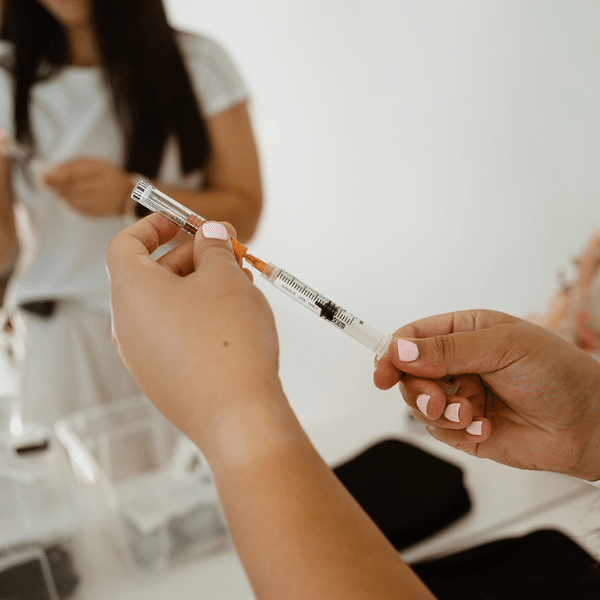The role of insulin in type 1 diabetes

The role of insulin in type 1 diabetes
If you or someone you love lives with type 1 diabetes (T1D), you probably know that in people living with T1D, the pancreas no longer makes insulin. As a result, people living with type 1 diabetes need to inject insulin to survive.
But what is insulin, how does it work, and are there different types? Are there different ways to administer it? Read on for our guide to insulin and everything you need to know about it.
What is insulin?
Insulin is a hormone that’s produced in the pancreas, which is a large gland located behind the stomach. The main job of the pancreas is to maintain healthy blood glucose levels.
Type 1 diabetes develops when the pancreas doesn’t produce enough insulin, or when the body can’t properly use the insulin that’s being produced (which is known as insulin resistance).
Without insulin, glucose builds up in your bloodstream, and can eventually lead to dangerously high blood glucose levels.
How does insulin work?
Insulin has a number of important functions, and is critical to your overall health and wellbeing.
In a healthy person, insulin production and release is a normal, regulated process that enables the body to meet its metabolic needs.
One of the biggest roles insulin plays is stimulating the update of glucose into your cells, almost like a key. When glucose enters your cells, it gives you energy, or it’s stored as glycogen until it’s needed. This process also lowers your blood glucose levels.
Insulin also has an impact on other metabolic processes, including the breakdown of fat or protein in the body.
Type 1 diabetes and insulin
If you have T1D, you’ve probably wondered why the body stops producing insulin. It’s a great question and one that’s been at the heart of diabetes research for decades.
Experts believe that type 1 diabetes is caused by an autoimmune reaction, where the body attacks itself by mistake. Following this reaction, the beta cells in the pancreas – the cells that make insulin – are destroyed. This process can go on for months or even years before you start to actually notice any type 1 diabetes symptoms.
Other possible ways type 1 diabetes develops could be down to your genes: some of us have certain genes that can make us more likely to develop the condition. Catching a virus could also trigger T1D.
Unlike with type 2 diabetes, your diet and lifestyle habits don’t play a part in developing the condition – it’s all about how the pancreas stops producing insulin.
How does insulin work in type 1 diabetes?
To answer this question, let’s take a step back and look at how things typically work in the body before type 1 diabetes develops.
Firstly, a healthy pancreas produces low levels of insulin throughout the day, which moves glucose from the bloodstream to your cells, to give you energy. After eating, your blood glucose level (BGL) rises and your pancreas produces a surge of insulin to quickly move the glucose into the muscles and liver (or stores it as glycogen) to keep your BGL stable.
If your BGL drops through the day, the glucogen is broken down and released back into your blood stream as glucose to balance your BGL. It’s a process that involves the pancreas sensing the amount of glucose in the bloodstream, then adjusting how much insulin it secretes to keep your BGL between 4 and 8 mmol/L at all times.
But with T1D, you need to manage this process manually by checking your BGL and adding insulin into your body. This can be a tricky process as your BGL can fluctuate a lot, even with your best efforts to eat well and administer the right amount of insulin. But if you get into the habit of tight glucose management, research shows this can reduce the complications of T1D by up to 76%.
Types of insulin
Thanks to a great deal of research and development, insulin has come a long way in the past 100 years. We’ve said goodbye to insulin preparations derived from animals that were first used in 1922. Today’s insulins are safer and more closely mimic the role of the pancreas.
In Australia, there are several types of insulin used to manage type 1 diabetes – and they differ depending on how fast they work, how quickly they ‘peak’ in the body and how long their effects last.
In order to function efficiently, your body needs what’s known as the basal bolus secretion (usually called ‘bolus’). This is a small amount of insulin that’s always in your blood if you don’t have diabetes. If you have T1D, you need to try and replicate this secretion, and you may need to take different types of insulin to do that.
The five main types are:
- rapid acting insulin analogues
- short acting insulin
- intermediate acting insulin
- long-acting insulin analogues
- pre-mixed insulin.
You could need a combination of different types of insulin to manage your T1D, and what you use may differ to someone else. Your healthcare team will create an insulin regimen that helps you maintain a healthy blood glucose level and ideally, one that helps you avoid hypos.
Rapid-acting or short-acting insulin
This type of insulin works fast, in as little as three minutes. This makes it ideal to use after you eat, as it helps prevent blood glucose spikes. It’s worth noting that they work for a shorter time as well.
Intermediate-acting insulin
This type of insulin takes longer to reach the bloodstream – as long as two to four hours after injection. It peaks four to 12 hours after entering the body, and lasts for 12-18 hours. It’s generally used between meals, when a small amount of insulin is needed to be working in the background to keep blood glucose levels in check.
Long-acting insulin
Similar to intermediate-acting insulin, long-acting insulin takes longer to kick in, but once it does, it provides a baseline level of insulin for most of the day, preventing blood glucose rising when rapid-acting insulins finish working.
Mixed insulin
Using a mixed insulin – which might combine very rapid-acting or short-acting insulin, along with intermediate-acting insulin – can allow someone with T1D have greater control over their blood glucose levels. It’s usually taken before meals.
How is insulin administered?
You might be wondering how you administer insulin – and the good news is, insulin delivery devices have advanced a great deal in the past couple of decades.
Syringes were once the standard way to inject insulin, but if you hate injections, there are lots of different options to investigate, including insulin pens and pumps.
Generally, insulin needs to be administered around 4-5 times a day, and is most effective when timed with or after meals.
Here’s a rundown of your choices when you have T1D.
Injection sites for Insulin
Injection rotation is something you’re likely to hear about when you start injecting insulin. It refers to varying where you inject to ensure the insulin gets absorbed consistently and doesn’t lead to a build-up of fatty tissue in one area of the body.
The ideal sites to inject into are those where you have a decent layer of fat: stomach, thighs, buttocks or upper arms are common injection sites for insulin. It’s worth noting that if you have less body fat the upper arms may not be a good site – there’s more chance of injecting into a muscle, which can lead to a hypo.
According to some studies, insulin absorbs most quickly when injected into the belly.
Insulin dose
Your healthcare team will work out an insulin regimen that suits you, taking into account factors such as your weight, age, diet, overall health and treatment goals.
It’s good to get to grips with how insulin doses can vary and what can affect absorption, as it can be a bit of trial and error to get your dosage right. For example, you might inject a dose before a meal and find that your BGL is too high after you’ve eaten, which would be a sign that you need to inject more insulin next time, to better balance your blood glucose levels.
Similarly, different types of insulin work differently in the body as we covered in this section. For example, long-acting insulin lasts for 20-24 hours, so you only need to take it once or twice a day, whereas regular or short-acting insulin (typically taken before a meal) takes affect within 30 minutes.
Seeing your healthcare team for regular reviews is important, as your dose can change over time due to a variety of factors, such as weight loss or gain, illness or medications.
Insulin syringes
Injecting insulin with a syringe used to be the most common way to deliver a dose into the body (although many adults these days use other methods).
Syringes come in various sizes, such as 30-unit (0.3m.), 50-unit (0.5ml) and 100-unit (1.0ml) measures. The size of the syringe you need depends on the insulin dose. Needle lengths on the syringe range from 6-8mm and your health care team will help you decide what’ll work best for you.
Syringes are disposed of after use (you can’t re-use it). They’re free for Australians who are registered with the National Diabetes Service Scheme (NDSS).
Insulin pumps
Insulin pumps are gaining in popularity with people who have T1D. They’re a computerised device about the size of a small mobile phone that are worn outside the body, delivering small continual doses of insulin into the body to keep your BGL stable between meals.
The pump contains a reservoir of insulin, and it’s programmed to deliver insulin into the body (usually through the abdomen) through a thin plastic tube. You can only use rapid-acting insulin in a pump. The tubing, known as an ‘infusion set’, has a fine needle or cannula inserted just below the skin that you need to change every two or three days.
JDRF administers the Federal Government’s Insulin Pump Program, which provides insulin pumps to families who have children (under 18) with T1D and meet the income threshold.
Insulin pens
Many people with T1D find insulin pens to be the most convenient delivery method, simply because they’re pre-loaded with the insulin dose and are discarded when they’re empty (or when the use-by date is reached). You should also discard pens that have been out of the fridge for one month.
You can get reusable insulin pens which require you to insert a 3ml insulin cartridge. When that’s finished, you refill the pen with a new cartridge.
Pen needles are disposable, and they’re screwed onto the pen device so you can inject the insulin. You can choose different lengths for these, ranging from 4-12.7mm, but research recommends 4-5mm pen needles are used. You’ll need to use a new pen needle with each injection, and your health care team can teach you the pen needle injection technique.
Conclusion
Discovering that you have T1D and needing to inject insulin can be a learning curve, whether you’re a child or an adult. But it’s easier than it’s ever been to manage the process, thanks to different types of insulins and delivery devices.
Want more info on type 1 diabetes and how to manage it? Check out our blog.
Sources
-
Diabetes and insulin (Better Health Channel)
-
Diabetes treatment: using insulin to manage blood sugar (Mayo Clinic)
-
Evolution of insulin delivery devices (Diabetes Ther.)
-
Insulin absorption from the abdomen and the thigh in healthy subjects during rest and exercise (Diabetologia)
-
Injection sites (Diabetes.co.uk)
-
Insulin routines (American Diabetes Association)
-
Pancreas hormones (Endocrine Society)
-
Type 1 diabetes and insulin (Health Central)
-
Type 1 diabetes treatment (JDRF Aus)
-
What is intermediate acting insulin (HealthCentral)
-
What is type 1 diabetes? (Centers for Disease Control and Prevention)

I’m interested in hearing more about…
